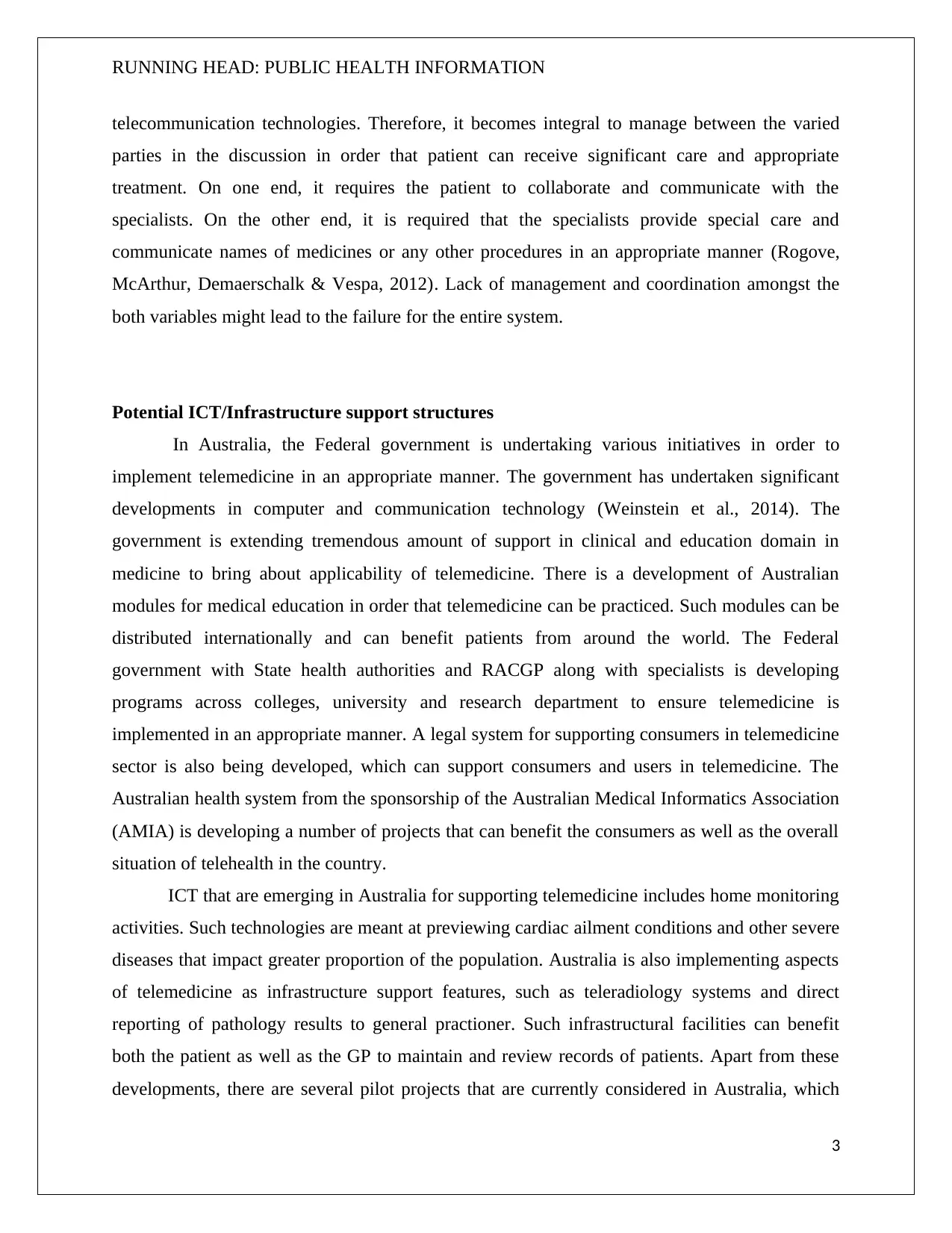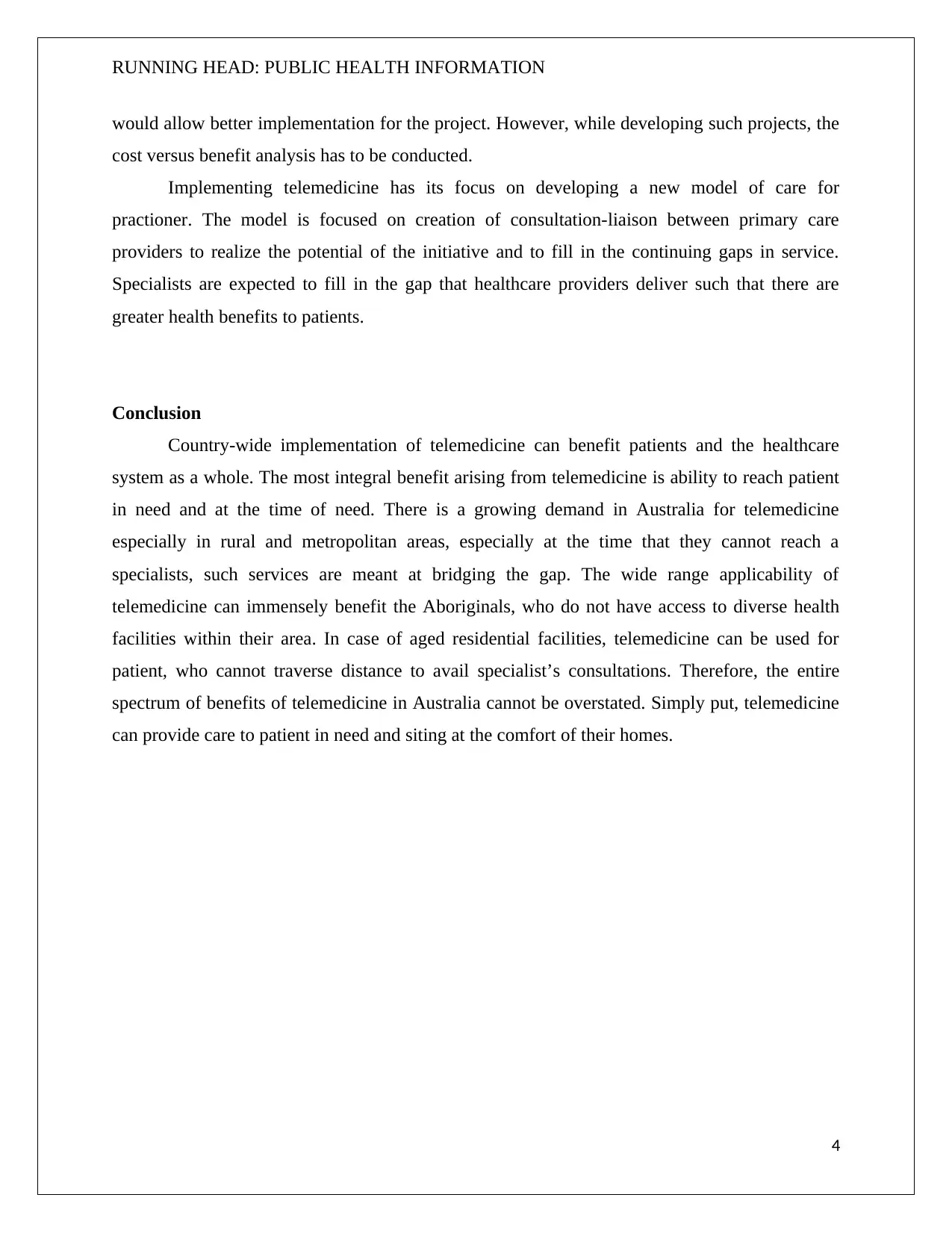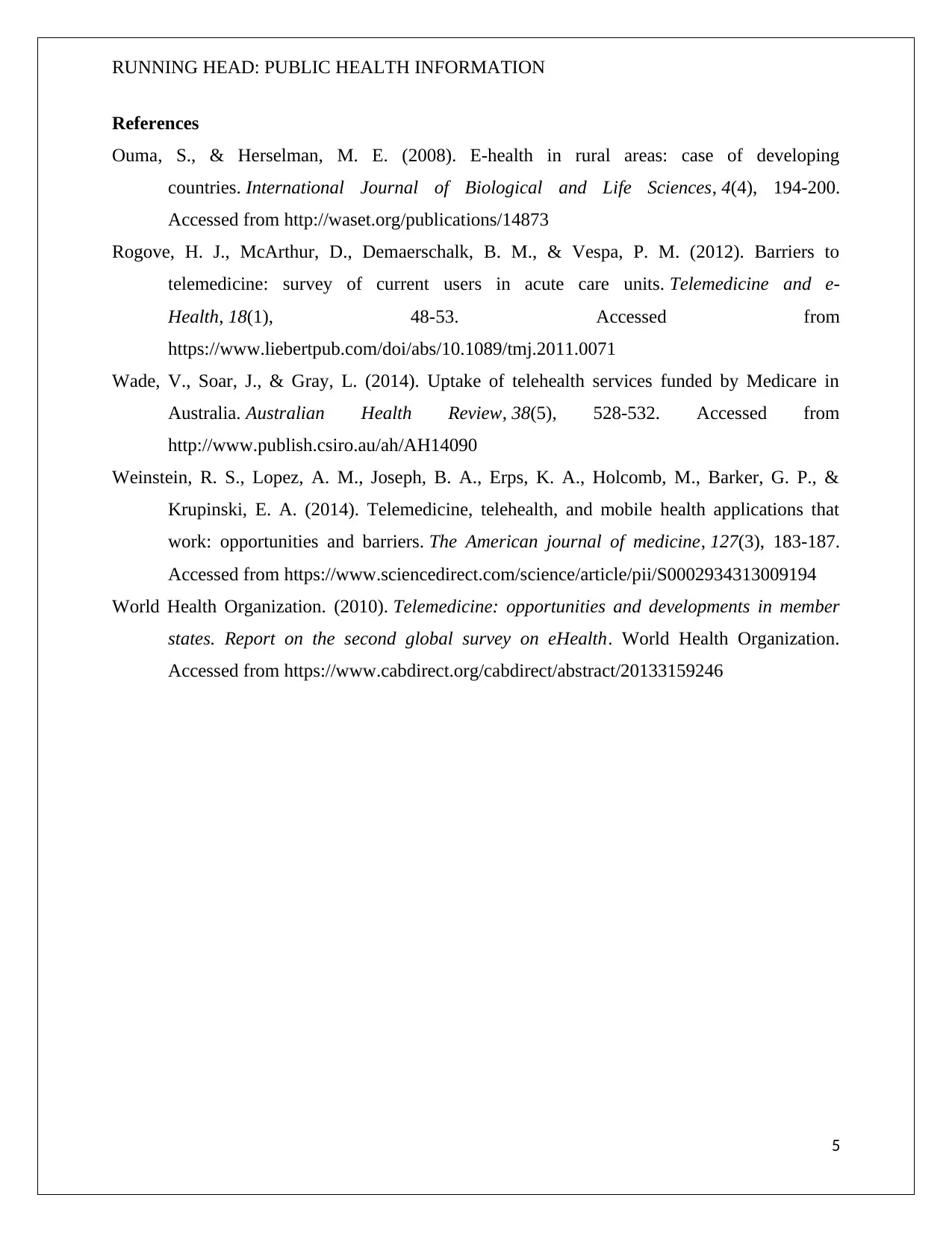Analysis of Telemedicine Uptake Barriers and Solutions
VerifiedAdded on 2023/06/04
|5
|1345
|354
Report
AI Summary
This report examines the barriers to the uptake of telemedicine services in Australia, focusing on the introduction of Medicare telehealth services in 2011. It identifies key challenges, including ICT infrastructure limitations such as lack of high-speed internet in remote areas, and management issues in coordinating care between specialists, patients, and other healthcare providers. The report also discusses government initiatives to improve telemedicine infrastructure, including support for clinical and educational programs, and the development of home monitoring systems and teleradiology. Furthermore, the report highlights the potential of telemedicine to reach patients in need, especially in rural and metropolitan areas and for Aboriginal health services, and suggests models of care to overcome the barriers. The conclusion emphasizes the benefits of telemedicine for both patients and the healthcare system, particularly in bridging the gap for those who cannot easily access specialist consultations.

RUNNING HEAD: PUBLIC HEALTH INFORMATION
PUBLIC HEALTH INFORMATION
1
PUBLIC HEALTH INFORMATION
1
Paraphrase This Document
Need a fresh take? Get an instant paraphrase of this document with our AI Paraphraser

RUNNING HEAD: PUBLIC HEALTH INFORMATION
Introduction
In the year 2011, the Australian Government introduced the facility of telehealth services
named Medicare (Ouma & Herselman, 2008). The entire focus of such telehealth services was
focused on delivering video consultations to varied patients. The scope of current discussion
takes into consideration barriers in uptake of telemedicine from the article by Wade, Soar, and
Gray (2014). Then it classifies the ICT/infrastructure issues present in telemedicine and ways in
which it can be managed. Models of care from the article have been included as well with
recommendations, which will allow in overcoming these barriers.
Barriers to the uptake of telemedicine,
The core aim to introduction of telemedicine in Australia is to provide consultation to
patients, who are based in rural and metropolitan locations, and also cater to Aboriginal Health
Services and residential aged care facilities (RACFs). Extension of telemedicine services
provides consultation in those areas where specialist’s workforce is limited and telehealth
initiative provides specialties at higher rebates than in-person consultation (World Health
Organization, 2010). However, there are certain barriers to the uptake of telemedicine which
includes ICT infrastructure and management tissues. ICT infrastructure is needed for the purpose
of providing telemedicines to patients, which includes video conferencing facilities,
uninterrupted internet connection, computer or laptop and last but not the least, capability to
operate on the telehealth portal. In most remote locations across Australia, healthcare service
delivery needs high speed internet, which is often lacking. Connecting to support wireless
technology is absent for most patients, who are unable to establish proper connection. Moreover,
in case the end user is not comfortable with the use of technology, then it becomes difficult for
specialists to conduct their workflow easily. Then a slower rate of adoption is expected and the
whole process becomes ineffective (Wade, Soar & Gray, 2014). Lack of ICT infrastructure in
most homes in Aboriginals, RACFs or rural and metropolitan sector deters applicability of the
service. Absence of proper ICT infrastructure hinders people from taking up services in
telemedicine.
Another pertinent challenge includes management issues. Applicability related to
telemedicine requires tremendous management capabilities and skills. The application of
telemedicine requires linking to doctors, nurses, specialists and patient by use of
2
Introduction
In the year 2011, the Australian Government introduced the facility of telehealth services
named Medicare (Ouma & Herselman, 2008). The entire focus of such telehealth services was
focused on delivering video consultations to varied patients. The scope of current discussion
takes into consideration barriers in uptake of telemedicine from the article by Wade, Soar, and
Gray (2014). Then it classifies the ICT/infrastructure issues present in telemedicine and ways in
which it can be managed. Models of care from the article have been included as well with
recommendations, which will allow in overcoming these barriers.
Barriers to the uptake of telemedicine,
The core aim to introduction of telemedicine in Australia is to provide consultation to
patients, who are based in rural and metropolitan locations, and also cater to Aboriginal Health
Services and residential aged care facilities (RACFs). Extension of telemedicine services
provides consultation in those areas where specialist’s workforce is limited and telehealth
initiative provides specialties at higher rebates than in-person consultation (World Health
Organization, 2010). However, there are certain barriers to the uptake of telemedicine which
includes ICT infrastructure and management tissues. ICT infrastructure is needed for the purpose
of providing telemedicines to patients, which includes video conferencing facilities,
uninterrupted internet connection, computer or laptop and last but not the least, capability to
operate on the telehealth portal. In most remote locations across Australia, healthcare service
delivery needs high speed internet, which is often lacking. Connecting to support wireless
technology is absent for most patients, who are unable to establish proper connection. Moreover,
in case the end user is not comfortable with the use of technology, then it becomes difficult for
specialists to conduct their workflow easily. Then a slower rate of adoption is expected and the
whole process becomes ineffective (Wade, Soar & Gray, 2014). Lack of ICT infrastructure in
most homes in Aboriginals, RACFs or rural and metropolitan sector deters applicability of the
service. Absence of proper ICT infrastructure hinders people from taking up services in
telemedicine.
Another pertinent challenge includes management issues. Applicability related to
telemedicine requires tremendous management capabilities and skills. The application of
telemedicine requires linking to doctors, nurses, specialists and patient by use of
2

RUNNING HEAD: PUBLIC HEALTH INFORMATION
telecommunication technologies. Therefore, it becomes integral to manage between the varied
parties in the discussion in order that patient can receive significant care and appropriate
treatment. On one end, it requires the patient to collaborate and communicate with the
specialists. On the other end, it is required that the specialists provide special care and
communicate names of medicines or any other procedures in an appropriate manner (Rogove,
McArthur, Demaerschalk & Vespa, 2012). Lack of management and coordination amongst the
both variables might lead to the failure for the entire system.
Potential ICT/Infrastructure support structures
In Australia, the Federal government is undertaking various initiatives in order to
implement telemedicine in an appropriate manner. The government has undertaken significant
developments in computer and communication technology (Weinstein et al., 2014). The
government is extending tremendous amount of support in clinical and education domain in
medicine to bring about applicability of telemedicine. There is a development of Australian
modules for medical education in order that telemedicine can be practiced. Such modules can be
distributed internationally and can benefit patients from around the world. The Federal
government with State health authorities and RACGP along with specialists is developing
programs across colleges, university and research department to ensure telemedicine is
implemented in an appropriate manner. A legal system for supporting consumers in telemedicine
sector is also being developed, which can support consumers and users in telemedicine. The
Australian health system from the sponsorship of the Australian Medical Informatics Association
(AMIA) is developing a number of projects that can benefit the consumers as well as the overall
situation of telehealth in the country.
ICT that are emerging in Australia for supporting telemedicine includes home monitoring
activities. Such technologies are meant at previewing cardiac ailment conditions and other severe
diseases that impact greater proportion of the population. Australia is also implementing aspects
of telemedicine as infrastructure support features, such as teleradiology systems and direct
reporting of pathology results to general practioner. Such infrastructural facilities can benefit
both the patient as well as the GP to maintain and review records of patients. Apart from these
developments, there are several pilot projects that are currently considered in Australia, which
3
telecommunication technologies. Therefore, it becomes integral to manage between the varied
parties in the discussion in order that patient can receive significant care and appropriate
treatment. On one end, it requires the patient to collaborate and communicate with the
specialists. On the other end, it is required that the specialists provide special care and
communicate names of medicines or any other procedures in an appropriate manner (Rogove,
McArthur, Demaerschalk & Vespa, 2012). Lack of management and coordination amongst the
both variables might lead to the failure for the entire system.
Potential ICT/Infrastructure support structures
In Australia, the Federal government is undertaking various initiatives in order to
implement telemedicine in an appropriate manner. The government has undertaken significant
developments in computer and communication technology (Weinstein et al., 2014). The
government is extending tremendous amount of support in clinical and education domain in
medicine to bring about applicability of telemedicine. There is a development of Australian
modules for medical education in order that telemedicine can be practiced. Such modules can be
distributed internationally and can benefit patients from around the world. The Federal
government with State health authorities and RACGP along with specialists is developing
programs across colleges, university and research department to ensure telemedicine is
implemented in an appropriate manner. A legal system for supporting consumers in telemedicine
sector is also being developed, which can support consumers and users in telemedicine. The
Australian health system from the sponsorship of the Australian Medical Informatics Association
(AMIA) is developing a number of projects that can benefit the consumers as well as the overall
situation of telehealth in the country.
ICT that are emerging in Australia for supporting telemedicine includes home monitoring
activities. Such technologies are meant at previewing cardiac ailment conditions and other severe
diseases that impact greater proportion of the population. Australia is also implementing aspects
of telemedicine as infrastructure support features, such as teleradiology systems and direct
reporting of pathology results to general practioner. Such infrastructural facilities can benefit
both the patient as well as the GP to maintain and review records of patients. Apart from these
developments, there are several pilot projects that are currently considered in Australia, which
3
⊘ This is a preview!⊘
Do you want full access?
Subscribe today to unlock all pages.

Trusted by 1+ million students worldwide

RUNNING HEAD: PUBLIC HEALTH INFORMATION
would allow better implementation for the project. However, while developing such projects, the
cost versus benefit analysis has to be conducted.
Implementing telemedicine has its focus on developing a new model of care for
practioner. The model is focused on creation of consultation-liaison between primary care
providers to realize the potential of the initiative and to fill in the continuing gaps in service.
Specialists are expected to fill in the gap that healthcare providers deliver such that there are
greater health benefits to patients.
Conclusion
Country-wide implementation of telemedicine can benefit patients and the healthcare
system as a whole. The most integral benefit arising from telemedicine is ability to reach patient
in need and at the time of need. There is a growing demand in Australia for telemedicine
especially in rural and metropolitan areas, especially at the time that they cannot reach a
specialists, such services are meant at bridging the gap. The wide range applicability of
telemedicine can immensely benefit the Aboriginals, who do not have access to diverse health
facilities within their area. In case of aged residential facilities, telemedicine can be used for
patient, who cannot traverse distance to avail specialist’s consultations. Therefore, the entire
spectrum of benefits of telemedicine in Australia cannot be overstated. Simply put, telemedicine
can provide care to patient in need and siting at the comfort of their homes.
4
would allow better implementation for the project. However, while developing such projects, the
cost versus benefit analysis has to be conducted.
Implementing telemedicine has its focus on developing a new model of care for
practioner. The model is focused on creation of consultation-liaison between primary care
providers to realize the potential of the initiative and to fill in the continuing gaps in service.
Specialists are expected to fill in the gap that healthcare providers deliver such that there are
greater health benefits to patients.
Conclusion
Country-wide implementation of telemedicine can benefit patients and the healthcare
system as a whole. The most integral benefit arising from telemedicine is ability to reach patient
in need and at the time of need. There is a growing demand in Australia for telemedicine
especially in rural and metropolitan areas, especially at the time that they cannot reach a
specialists, such services are meant at bridging the gap. The wide range applicability of
telemedicine can immensely benefit the Aboriginals, who do not have access to diverse health
facilities within their area. In case of aged residential facilities, telemedicine can be used for
patient, who cannot traverse distance to avail specialist’s consultations. Therefore, the entire
spectrum of benefits of telemedicine in Australia cannot be overstated. Simply put, telemedicine
can provide care to patient in need and siting at the comfort of their homes.
4
Paraphrase This Document
Need a fresh take? Get an instant paraphrase of this document with our AI Paraphraser

RUNNING HEAD: PUBLIC HEALTH INFORMATION
References
Ouma, S., & Herselman, M. E. (2008). E-health in rural areas: case of developing
countries. International Journal of Biological and Life Sciences, 4(4), 194-200.
Accessed from http://waset.org/publications/14873
Rogove, H. J., McArthur, D., Demaerschalk, B. M., & Vespa, P. M. (2012). Barriers to
telemedicine: survey of current users in acute care units. Telemedicine and e-
Health, 18(1), 48-53. Accessed from
https://www.liebertpub.com/doi/abs/10.1089/tmj.2011.0071
Wade, V., Soar, J., & Gray, L. (2014). Uptake of telehealth services funded by Medicare in
Australia. Australian Health Review, 38(5), 528-532. Accessed from
http://www.publish.csiro.au/ah/AH14090
Weinstein, R. S., Lopez, A. M., Joseph, B. A., Erps, K. A., Holcomb, M., Barker, G. P., &
Krupinski, E. A. (2014). Telemedicine, telehealth, and mobile health applications that
work: opportunities and barriers. The American journal of medicine, 127(3), 183-187.
Accessed from https://www.sciencedirect.com/science/article/pii/S0002934313009194
World Health Organization. (2010). Telemedicine: opportunities and developments in member
states. Report on the second global survey on eHealth. World Health Organization.
Accessed from https://www.cabdirect.org/cabdirect/abstract/20133159246
5
References
Ouma, S., & Herselman, M. E. (2008). E-health in rural areas: case of developing
countries. International Journal of Biological and Life Sciences, 4(4), 194-200.
Accessed from http://waset.org/publications/14873
Rogove, H. J., McArthur, D., Demaerschalk, B. M., & Vespa, P. M. (2012). Barriers to
telemedicine: survey of current users in acute care units. Telemedicine and e-
Health, 18(1), 48-53. Accessed from
https://www.liebertpub.com/doi/abs/10.1089/tmj.2011.0071
Wade, V., Soar, J., & Gray, L. (2014). Uptake of telehealth services funded by Medicare in
Australia. Australian Health Review, 38(5), 528-532. Accessed from
http://www.publish.csiro.au/ah/AH14090
Weinstein, R. S., Lopez, A. M., Joseph, B. A., Erps, K. A., Holcomb, M., Barker, G. P., &
Krupinski, E. A. (2014). Telemedicine, telehealth, and mobile health applications that
work: opportunities and barriers. The American journal of medicine, 127(3), 183-187.
Accessed from https://www.sciencedirect.com/science/article/pii/S0002934313009194
World Health Organization. (2010). Telemedicine: opportunities and developments in member
states. Report on the second global survey on eHealth. World Health Organization.
Accessed from https://www.cabdirect.org/cabdirect/abstract/20133159246
5
1 out of 5
Related Documents
Your All-in-One AI-Powered Toolkit for Academic Success.
+13062052269
info@desklib.com
Available 24*7 on WhatsApp / Email
![[object Object]](/_next/static/media/star-bottom.7253800d.svg)
Unlock your academic potential
Copyright © 2020–2026 A2Z Services. All Rights Reserved. Developed and managed by ZUCOL.





